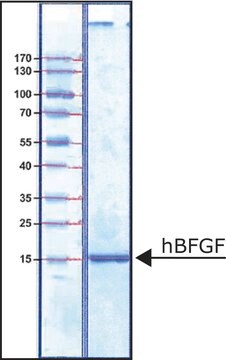F8424
Fibroblast Growth Factor-4 human
FGF-4, recombinant, expressed in E. coli, lyophilized powder, suitable for cell culture
Sinonimo/i:
hFGF-4, FGF-4, K-FGF
About This Item
Prodotti consigliati
Origine biologica
human
Livello qualitativo
Ricombinante
expressed in E. coli
Saggio
≥95% (SDS-PAGE and HPLC)
Stato
lyophilized powder
Potenza
≤10.0 ng/mL
Qualità
endotoxin tested
PM
19 kDa
Confezionamento
pkg of 25 and 100 μg
Condizioni di stoccaggio
avoid repeated freeze/thaw cycles
tecniche
cell culture | mammalian: suitable
Impurezze
<1 EU/μg
N° accesso UniProt
Temperatura di conservazione
−20°C
Informazioni sul gene
human ... FGF4(2249) , FGF4(2249)
Cerchi prodotti simili? Visita Guida al confronto tra prodotti
Categorie correlate
Descrizione generale
Applicazioni
- To maintain trophectoderm stem cells.
- In neurogenic differentiation.
- In hepatocyte differentiation.
Azioni biochim/fisiol
Stato fisico
Risultati analitici
Codice della classe di stoccaggio
11 - Combustible Solids
Classe di pericolosità dell'acqua (WGK)
WGK 3
Punto d’infiammabilità (°F)
Not applicable
Punto d’infiammabilità (°C)
Not applicable
Dispositivi di protezione individuale
Eyeshields, Gloves, type N95 (US)
Scegli una delle versioni più recenti:
Possiedi già questo prodotto?
I documenti relativi ai prodotti acquistati recentemente sono disponibili nell’Archivio dei documenti.
Articoli
Fibroblast growth factors in cell culture and various growth factors for your research
Il team dei nostri ricercatori vanta grande esperienza in tutte le aree della ricerca quali Life Science, scienza dei materiali, sintesi chimica, cromatografia, discipline analitiche, ecc..
Contatta l'Assistenza Tecnica.


